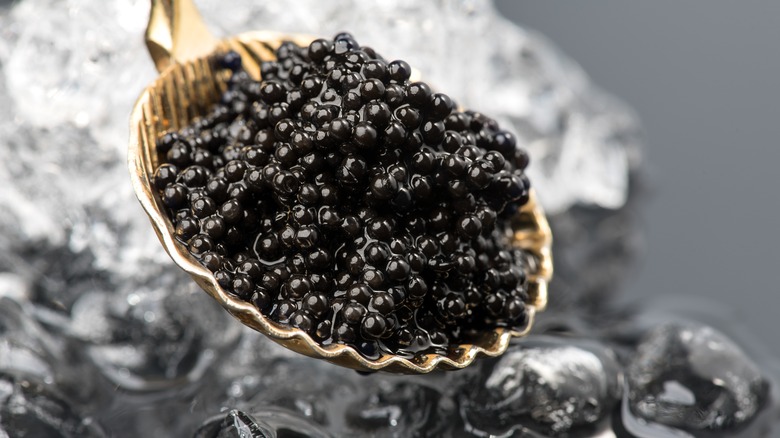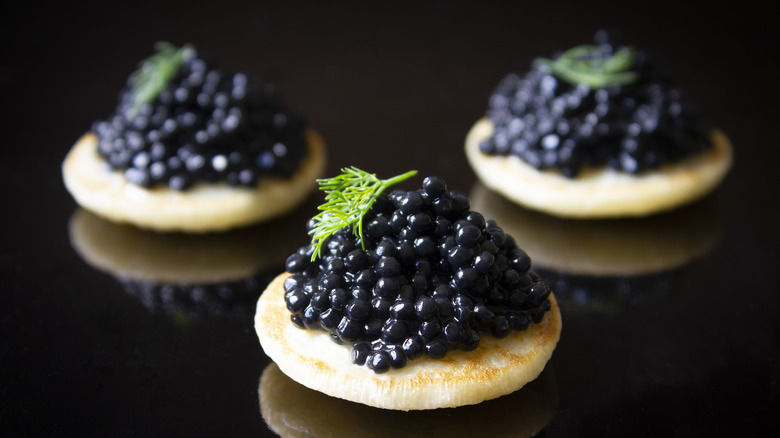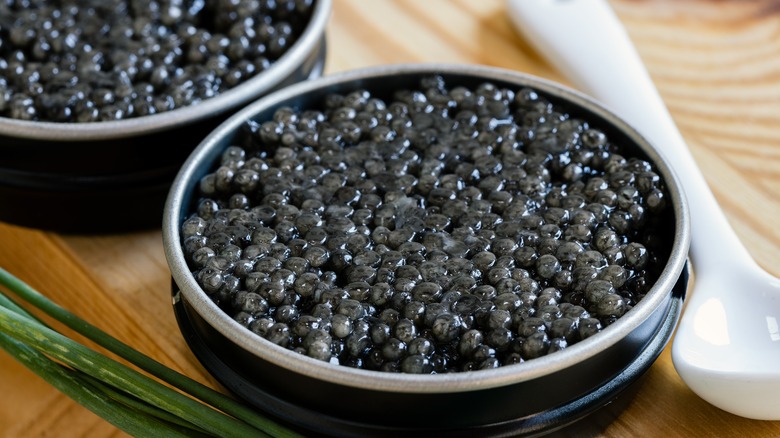Should You Or Should You Not Chew Caviar?
A traditional myth about caviar is that chewing these salt-cured fish eggs is essential to a satisfying tasting experience. However, that isn't really the case, which is why this advice qualifies as an old wives' tale. What chewing actually does is move the roe from your tongue, which is rife with flavor receptors, to between your teeth, where there are none. The best way to savor the salty, buttery piquancy and aroma of caviar is to keep it on your tongue until it melts.
But before depositing it there — ideally with a mother-of-pearl spoon, to avoid any metallic aftertaste — you'll first want to hold it under your nose like a fine wine to fully take in its distinct scent. Then, when you're ready for more filling pleasures, guide the spoon into your mouth before flipping it over, so that the eggs, not the utensil, make the first contact.
Since chewing is out of the question, you'll want to take only a small spoonful into your mouth for each "bite." This shouldn't prove difficult. Caviar is famously expensive, and it's also commonly served as an appetizer. Both factors contribute to its typically modest serving sizes.
Similarities between caviar and wine tasting
Eating caviar is a luxury experience often compared to wine tasting. For starters, just as there are numerous varieties of wine, there are many types of caviar, each exhibiting varying degrees of quality. Similarly, terroir, or growing conditions, matter in both realms, and like the finest wine producers, top caviar farms sometimes age their product to enhance its quality.
Tasting these two delicacies reveals further similarities. Wine connoisseurs often swirl the liquid in their mouths before swallowing to expose more of it to their taste receptors. Experienced caviar tasters do something similar, though in this case, it involves a gentle rolling of the eggs around the tongue to savor their flavor and buttery texture before they dissolve. Pressing the caviar against the roof of your mouth with your tongue can also enhance the tasting experience.
While a sip of Champagne or wine can cleanse your palate afterward, despite the similarities in tasting caviar and wine, this isn't the ideal pairing. One of the best accompaniments for caviar — aside from potato chips — is vodka.
The main types of caviar to buy
Caviar is now found on a variety of dishes, from crackers to blinis to toast, but only select fish roe earn this coveted designation — those sourced from sturgeon, to be precise. Twenty-nine species of this ancient fish, which have been around for nearly 174 million years, are still extant, but only a few of them produce the eggs that command famously high prices. Beluga caviar, the world's best and most expensive variety, is named after the beluga sturgeon and can sell for more than $175 an ounce. Ossetra (or Osetra) and Sevruga, also highly valued, are named after their respective sturgeon species.
Each type of fish produces eggs with distinct colors and qualities. Ossetra eggs can have an almost gold color, while Sevruga's are typically in various shades of gray. Beluga eggs range from gray to black and, like most caviar, are cured using the Malossol technique, a preservation method that employs a low salt content to maximize both flavor and shelf life.
Once packed in tins and sold, the recommended serving size per person is 30 to 50 grams. This modest amount allows for small spoonfuls, ensuring the caviar melts in your mouth, and is not wasted by chewing.



